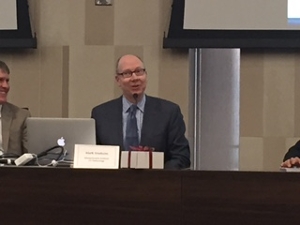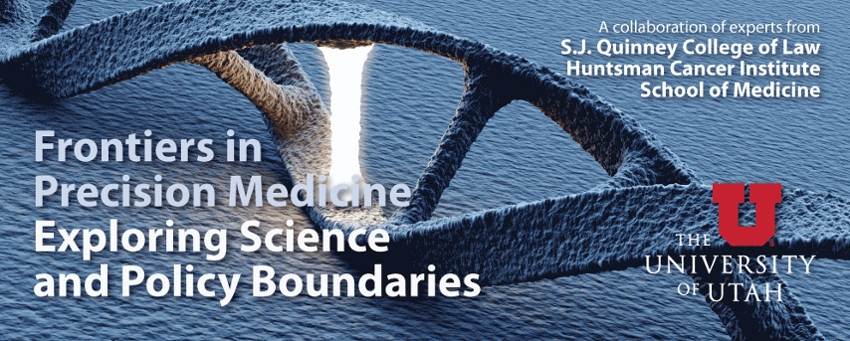
Precision medicine may make health care better, but don’t expect it to make it more affordable.
Genetically targeting therapies to those patients most likely to benefit spares them the time and toxicity of trying ineffective drugs. That’s a good thing for patients, and in theory, a money-saver.
But the economics of drug discovery suggest otherwise, according to Mark Trusheim, a biomedical industry consultant and visiting scientist at the Massachusetts Institute of Technology’s Sloan School of Management.
Drugs take a lot of time and money to create—10 to 15 years on average and $1 billion or more— and drug companies have to recoup those costs for their investors, or risk losing investment to more lucrative enterprises, explained Trusheim, speaking Friday at a University of Utah-sponsored precision medicine conference. The list price of a drug, in other words, is dependent on how much of it the manufacturer expects to sell. As medicines become more precise in their targeting of disease, the patient populations benefitting from them shrink along with the drug manufacturer’s market. And you can be sure, argued Trusheim, that this will translate to higher prices.

“Would you rather be the patient who spends $46,000, not knowing whether [a given drug] is going to work or not…or the patient who has a nearly 90 percent chance of responding [to the drug] but must pay $120,000?” asked Trusheim, referring to a hypothetical pricing scenario. Either way, the drug maker’s profit is the same, which means no societal relief from soaring drug costs. “Payers are still spending the same,” Trusheim said.
Putting aside debate over the fairness of pharmaceutical profiteering, Trusheim frames the issue as a matter of economics and, more specifically, of value. How much value do we attach to these specially tailored medicines? Do they cure a disease or extend life by only a few weeks or months? How horrible are the side effects that they help patients avoid? And how reliable are the diagnostic tests used to determine who gets the drug and who doesn’t?
“Do you want to pay for new health and cures, or are you really wanting today’s health status for cheaper? If you don’t want any new drugs, you don’t have to have them. The current brands of drugs will go off patent and we’ll have 2015 health status forever,” said Trusheim. “But if you want new drugs, then you should be willing to pay for more health. If we as a society can’t afford that then we ought to make a different choice. But you ought to be clear about the choice that you’re making and not just say it’s costing too much.”
It’s a persuasive argument, but not everyone is as pessimistic about precision medicine’s money-saving prospects. A torrent of wasteful medical care in the U.S. is harming patients and driving up spending, argued another conference speaker Willard Dere, M.D., a former pharmaceutical industry executive and director of the University of Utah’s personalized health program. “As you look at Medicare participants, it’s estimated that 40 percent of them are getting interventions that professional societies view as unnecessary.”
That includes drugs, but also unnecessary tests and non-therapeutic interventions, and there exist proven clinical tools for risk-stratifying patients to understand who will benefit from those interventions and who won’t, Dere argued.
Having said that, Dere also strongly believes that “value” should factor into decisions to invest in new medical advances, which is why the University of Utah has adopted this broad definition of precision medicine: Delivering the right intervention to the right patient at the right time, and for the right cost.
The trick is getting all the stakeholders in health care to put aside their personal agendas and agree to work toward this greater societal good. That’s happening on an ad hoc basis, said Eric Hales of Regence BlueCross BlueShield of Utah, pointing to investments by insurers in tools to help consumers make smarter health purchasing decisions.
A more coordinated effort by the government, though, is needed to really extract value from the health supply chain, argued Trusheim. “Even though Medicare pays at the end and [the National Institutes of Health (NIH)] pays at the beginning, and the FDA regulates throughout, we have no connection or coordination between what does Medicare think the needs are that NIH ought to be funding.”
That level of coordination may seem far-fetched in today’s divided political climate, but policy makers don’t need to look very far for successful models.
“If you look at NASA and our space efforts and if you look at our military, we have an integrated government supply chain from innovation to purchasing and distribution. NASA decides they want to go to Mars,…they pay for the R & D work and get competitive bids for who gets to build the rockets,” Trusheim said. “And it works pretty well. We have the best military in the world.”

Kirsten Stewart is a senior writer for University of Utah Health Sciences